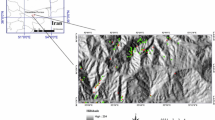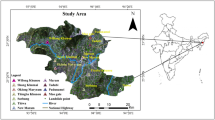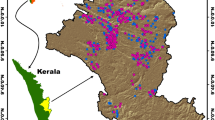Abstract
Producing reliable landslide susceptibility maps is crucial for effective landslide prevention. However, previous studies have placed less emphasis on the technique for dividing attribute intervals of evaluation factors when assessing landslide susceptibility. This study aims to compare the influences of the natural breaks method and the frequency ratio method (FR) as techniques for dividing attribute intervals of continuous evaluation factors. Additionally, different susceptibility assessment models, including frequency ratio (FR), frequency ratio coupled with analytic hierarchy process (FR-AHP), frequency ratio coupled with BP neural network (FR-BP), and frequency ratio coupled with mean impact value and BP neural network (FR-MIV-BP), were utilized to explore landslide susceptibility in Huichang County and its surrounding areas. Based on field investigations and correlation analysis, ten evaluation factors were selected, comprising land use, lithology, plan curvature, profile curvature, slope, aspect, elevation, distance to fault, distance to road, and normalized vegetation index (NDVI). Finally, the uncertainties were tested using receiver operating characteristic curves (ROC) and the distribution law of susceptibility index. The results indicated that the FR method yielded higher accuracy than the natural breaks method in dividing attribute intervals. The MIV algorithm optimized BP neural network demonstrated a 0.7 to 0.8% improvement compared to the traditional BP neural network. The FR-MIV-BP models exhibited smaller mean values and larger standard deviations for the landslide susceptibility index, suggesting better alignment with the actual landslide distribution features. This study has important implications for selecting evaluation factor division methods and appropriate models, providing valuable landslide susceptibility mapping for disaster prevention in Huichang County and its surrounding areas.









Similar content being viewed by others
References
Abudikeyimu X, He S (2019) Spatial prediction on landslide vulnerability based on MIV - BP neural network. Yangtze River(in Chinese) 50:140–144. https://doi.org/10.16232/j.cnki.1001-4179.2019.11.023
Aditian A, Kubota T, Shinohara Y (2018) Comparison of GIS-based landslide susceptibility models using frequency ratio, logistic regression, and artificial neural network in a tertiary region of Ambon, Indonesia. Geomorphology 318:101–111. https://doi.org/10.1016/j.geomorph.2018.06.006
Alsabhan AH, Singh K, Sharma A, Alam S, Pandey DD, Rahman SAS, Khursheed A, Munshi FM (2022) Landslide susceptibility assessment in the Himalayan range based along Kasauli – Parwanoo road corridor using weight of evidence, information value, and frequency ratio. J King Saud Unv Sci 34:101759. https://doi.org/10.1016/j.jksus.2021.101759
Arabameri A, Pradhan B, Rezaei K, Lee CW (2019) Assessment of landslide susceptibility using statistical- and artificial intelligence-based FR–RF integrated model and multiresolution DEMs. Remote Sens 11:999. https://doi.org/10.3390/rs11090999
Budimir MEA, Atkinson PM, Lewis HG (2015) A systematic review of landslide probability mapping using logistic regression. Landslides 12:419–436. https://doi.org/10.1007/s10346-014-0550-5
Can A, Dagdelenler G, Ercanoglu M, Sonmez H (2019) Landslide susceptibility mapping at Ovacık-Karabük (Turkey) using different artificial neural network models: comparison of training algorithms. Bull Eng Geol Environ 78:89–102. https://doi.org/10.1007/s10064-017-1034-3
Chen W, Li WP, Ek H, Zhao Z, Deng ND, Bai HY, Wang DZ (2014) Landslide susceptibility mapping based on GIS and information value model for the Chencang District of Baoji, China. Arab J Geosci 7:4499–4511. https://doi.org/10.1007/s12517-014-1369-z
Chen W, Panahi M, Tsangaratos P, Shahabi H, Ilia I, Panahi S, Li S, Jaafari A, Ahmad BB (2019) Applying population-based evolutionary algorithms and a neuro-fuzzy system for modeling landslide susceptibility. Catena 172:212–231. https://doi.org/10.1016/j.catena.2018.08.025
Cruden D, Varnes DJ (1996) Landslide types and processes. In: Turner AK, Schuster RL (eds) Landslides: investigation and mitigation, vol 247. National Academy Press, Washington, D.C, pp 36–75
Das S, Sarkar S, Kanungo DP (2022) GIS-based landslide susceptibility zonation mapping using the analytic hierarchy process (AHP) method in parts of Kalimpong Region of Darjeeling Himalaya. Environ Monit Assess 194:234. https://doi.org/10.1007/s10661-022-09851-7
Dombi GW, Nandi P, Saxe JM, Ledgerwood AM, Lucas CE (1995) Prediction of Rib fracture injury outcome by an artificial neural network. J Trauma 39:915–921. https://doi.org/10.1097/00005373-199511000-00016
Dou J, Yamagishi H, Pourghasemi HR, Yunus AP, Song X, Xu Y, Zhu Z (2015) An integrated artificial neural network model for the landslide susceptibility assessment of Osado Island, Japan. Nat Hazards 78:1749–1776. https://doi.org/10.1007/s11069-015-1799-2
Fujita A, Sato JR, Demasi MAA, Sogayar MC, Ferreira CE, Miyano S (2009) Comparing Pearson, Spearman and Hoeffding’s D measure for gene expression association analysis. J Bioinf Comput Biol 7:663–684
Huang FM, Ye Z, Jiang SH, Huang JS, Chang ZL, Chen JW (2021) Uncertainty study of landslide susceptibility prediction considering the different attribute interval numbers of environmental factors and different data-based models. Catena 202:105250. https://doi.org/10.1016/j.catena.2021.105250
Ilia I, Tsangaratos P (2016) Applying weight of evidence method and sensitivity analysis to produce a landslide susceptibility map. Landslides 13:379–397. https://doi.org/10.1007/s10346-015-0576-3
Jiang WG, Rao PZ, Cao R, Tang ZH, Chen K (2017) Comparative evaluation of geological disaster susceptibility using multi-regression methods and spatial accuracy validation. J Geogr Sci 27:439–462. https://doi.org/10.1007/s11442-017-1386-4
Khan H, Shafique M, Khan MA, Bacha MA, Shah SU, Calligaris C (2019) Landslide susceptibility assessment using frequency ratio, a case study of northern Pakistan. Egypt J Remote Sens 22:11–24. https://doi.org/10.1016/j.ejrs.2018.03.004
Lee S, Pradhan B (2007) Landslide hazard mapping at Selangor, Malaysia using frequency ratio and logistic regression models. Landslides 4:33–41. https://doi.org/10.1007/s10346-006-0047-y
Li LP, Lan HX, Guo CB, Zhang YS, Li QW, Wu YM (2017) A modified frequency ratio method for landslide susceptibility assessment. Landslides 14:727–741. https://doi.org/10.1007/s10346-016-0771-x
Ma ZJ, Mei G (2021) Deep learning for geological hazards analysis: data, models, applications, and opportunities. Earth-Sci Rev 223:103858. https://doi.org/10.1016/j.earscirev.2021.103858
Meena SR, Ghorbanzadeh O, Blaschke T (2019) A comparative study of statistics-based landslide susceptibility models: a case study of the region affected by the Gorkha earthquake in Nepal. Isprs Int J Geo-Inf 8:94. https://doi.org/10.3390/ijgi8020094
Nahayo L, Kalisa E, Maniragaba A, Nshimiyimana FX (2019) Comparison of analytical hierarchy process and certain factor models in landslide susceptibility mapping in Rwanda. Model Earth Syst Env 5:885–895. https://doi.org/10.1007/s40808-019-00575-1
Pourghasemi HR, Jirandeh AG, Pradhan B, Xu C, Gokceoglu C (2013) Landslide susceptibility mapping using support vector machine and GIS at the Golestan Province. Iran. J Earth Syat Sci 122:349–369. https://doi.org/10.1007/s12040-013-0282-2
Pourghasemi HR, Pradhan B, Gokceoglu C (2012) Application of fuzzy logic and analytical hierarchy process (AHP) to landslide susceptibility mapping at Haraz watershed, Iran. Nat Hazards 63:965–996. https://doi.org/10.1007/s11069-012-0217-2
Pradhan B, Lee S (2010) Regional landslide susceptibility analysis using back-propagation neural network model at Cameron Highland, Malaysia. Landslides 7:13–30. https://doi.org/10.1007/s10346-009-0183-2
Qin YG, Yang GL, Lu KP, Sun QZ, Xie J, Wu YW (2021) Performance evaluation of five GIS-based models for landslide susceptibility prediction and mapping: a case study of Kaiyang County, China. Sustainability 13:6441. https://doi.org/10.3390/su13116441
Regmi AD, Devkota KC, Yoshida K, Pradhan B, Pourghasemi HR, Kumamoto T, Akgun A (2014) Application of frequency ratio, statistical index, and weights-of-evidence models and their comparison in landslide susceptibility mapping in Central Nepal Himalaya. Arab J Geosci 7:725–742. https://doi.org/10.1007/s12517-012-0807-z
Saaty TL (1977) A scaling method for priorities in hierarchical structures. J Mathpsychol 15:234–281. https://doi.org/10.1016/0022-2496(77)90033-5
Sun DL, Xu JH, Wen HJ, Wang Y (2020) An optimized random forest model and its generalization ability in landslide susceptibility mapping: application in two areas of Three Gorges Reservoir, China. J Earth Sci 31:1068–1086. https://doi.org/10.1007/s12583-020-1072-9
Trigila A, Iadanza C, Esposito C, Scarascia Mugnozza G (2015) Comparison of Logistic Regression and Random Forests techniques for shallow landslide susceptibility assessment in Giampilieri (NE Sicily, Italy). Geomorphology 249:119–136. https://doi.org/10.1016/j.geomorph.2015.06.001
Vakhshoori V, Zare M (2016) Landslide susceptibility mapping by comparing weight of evidence, fuzzy logic, and frequency ratio methods. Geoamat Nat Haz Risk 7:1731–1752. https://doi.org/10.1080/19475705.2016.1144655
Wang F, Xu PH, Wang CM, Wang N, Jiang N (2017) Application of a GIS-based slope unit method for landslide susceptibility mapping along the Longzi River, Southeastern Tibetan Plateau, China. Isprs Int J Geo-Inf 6:172. https://doi.org/10.3390/ijgi6060172
Wang Y, Fang ZC, Hong HY (2019) Comparison of convolutional neural networks for landslide susceptibility mapping in Yanshan County, China. Sci Total Environ 666:975–993. https://doi.org/10.1016/j.scitotenv.2019.02.263
Yan JS, Tan JM (2019) Landslide susceptibility assessment based on different factor classification methods—a case study in Yuan’an County of Hubei Province. The Chin J Geol Hazard Control(in Chinese) 30:52–60. https://doi.org/10.16031/j.cnki.issn.1003-8035.2019.01.06
Yao X, Tham LG, Dai FC (2008) Landslide susceptibility mapping based on support vector machine: a case study on natural slopes of Hong Kong, China. Geomorphology 101:572–582. https://doi.org/10.1016/j.geomorph.2008.02.011
Yu CL, Chen JP (2020) Application of a GIS-based slope unit method for landslide susceptibility mapping in Helong City: comparative assessment of ICM, AHP, and RF model. Symmetry 12:1848. https://doi.org/10.3390/sym12111848
Zhang TY, Han L, Chen W, Shahabi H (2018) Hybrid integration approach of entropy with logistic regression and support vector machine for landslide susceptibility modeling. Entropy 20:884. https://doi.org/10.3390/e20110884
Zhao Y, Wang R, Jiang Y, Liu H, Wei Z (2019) GIS-based logistic regression for rainfall-induced landslide susceptibility mapping under different grid sizes in Yueqing, Southeastern China. Eng Geol 259:105147. https://doi.org/10.1016/j.enggeo.2019.105147
Zhu CH, Zhang JJ, Liu Y, Ma DH, Li MF, Xiang B (2020) Comparison of GA-BP and PSO-BP neural network models with initial BP model for rainfall-induced landslides risk assessment in regional scale: a case study in Sichuan, China. Nat Hazards 100:173–204. https://doi.org/10.1007/s11069-019-03806-x
Acknowledgements
The authors’ special appreciation goes to the editor and reviewers of this manuscript for their valuable comments and suggestions. And we sincerely thank Dr. Feng Liang from Jiangxi University of Science and Technology for his guidance on English writing of this manuscript.
Author information
Authors and Affiliations
Corresponding author
Ethics declarations
Conflict of interest
The authors declare no competing interests.
Rights and permissions
Springer Nature or its licensor (e.g. a society or other partner) holds exclusive rights to this article under a publishing agreement with the author(s) or other rightsholder(s); author self-archiving of the accepted manuscript version of this article is solely governed by the terms of such publishing agreement and applicable law.
About this article
Cite this article
Ke, C., He, S. & Qin, Y. Comparison of natural breaks method and frequency ratio dividing attribute intervals for landslide susceptibility mapping. Bull Eng Geol Environ 82, 384 (2023). https://doi.org/10.1007/s10064-023-03392-0
Received:
Accepted:
Published:
DOI: https://doi.org/10.1007/s10064-023-03392-0




